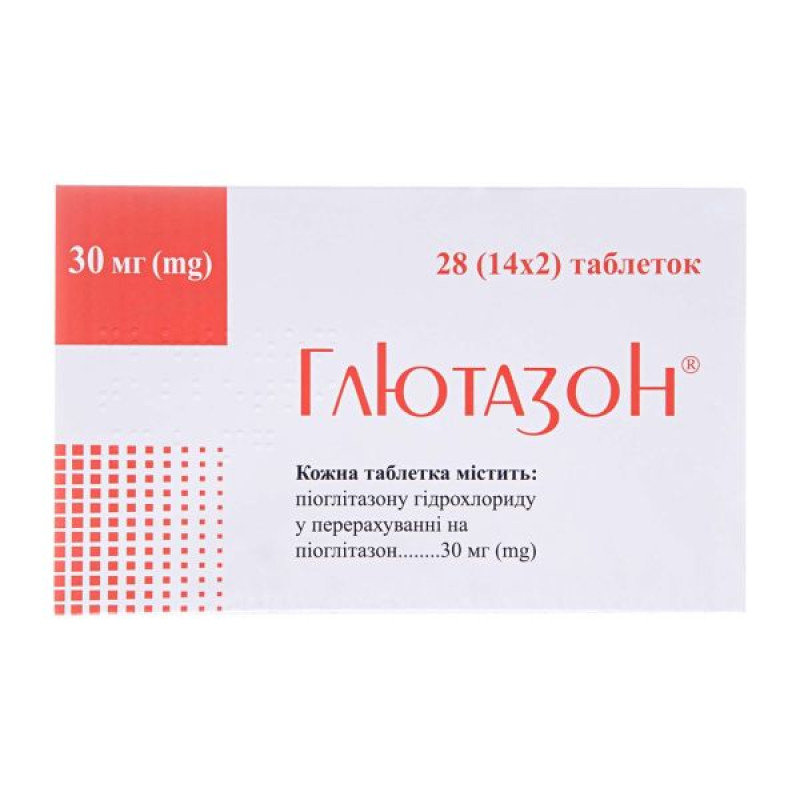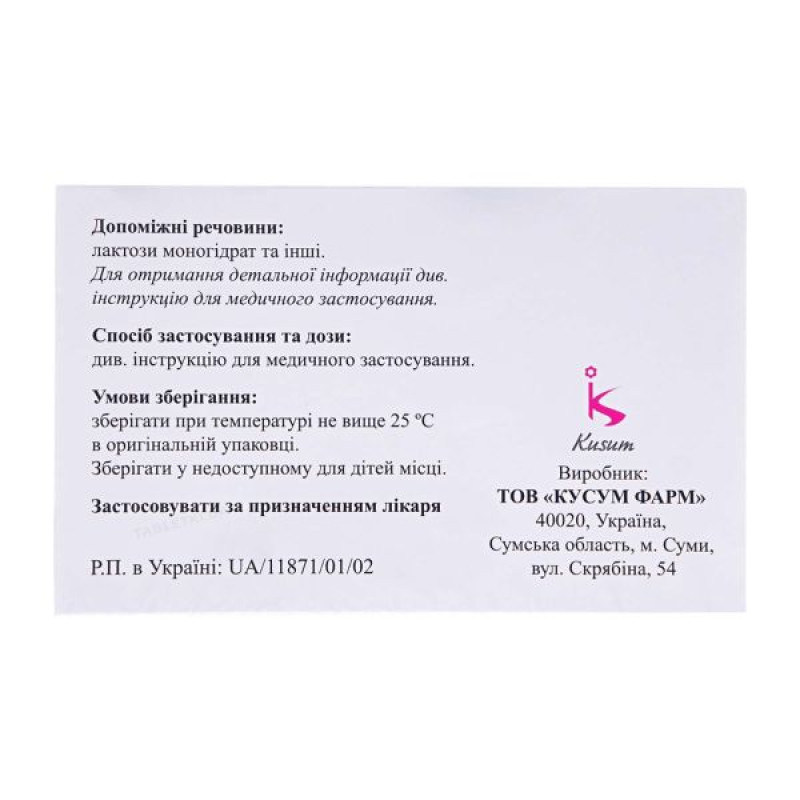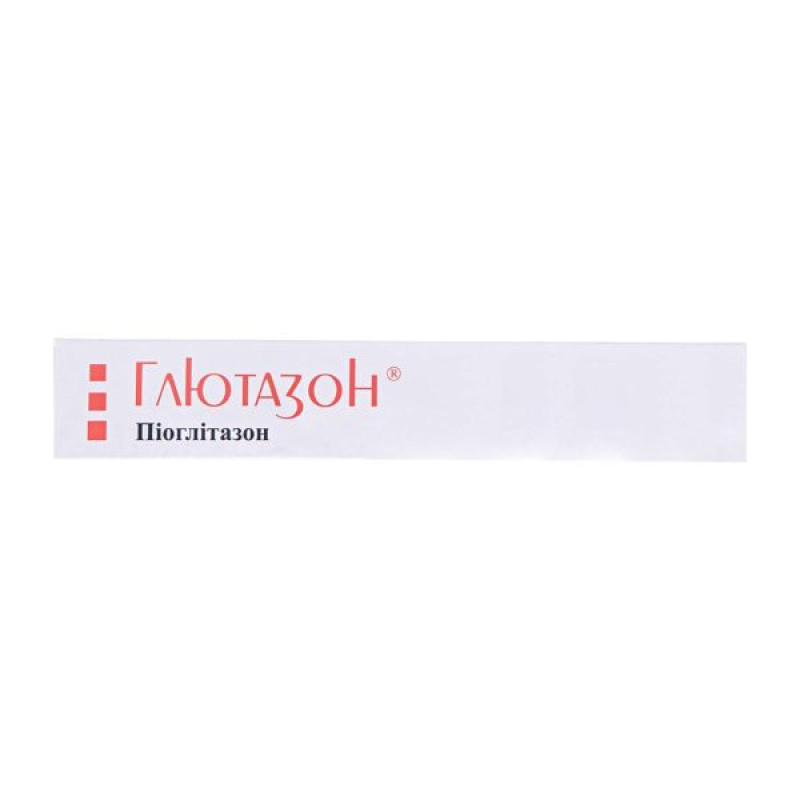Glutazone tablets 30 mg blister No. 28

Instructions Glutazone tablets 30 mg blister No. 28
Composition
active ingredient: pioglitazone;
1 tablet contains pioglitazone hydrochloride equivalent to pioglitazone 15 mg or 30 mg or 45 mg;
excipients: lactose monohydrate, hydroxypropylcellulose, calcium carboxymethylcellulose, magnesium stearate.
Dosage form
Pills.
Main physicochemical properties:
15 mg tablets: white, round, flat tablets debossed with “K” on one side and plain on the other;
30 mg tablets: white, round, biconvex tablets, smooth on both sides;
45 mg tablets: white, round, biconvex tablets, smooth on both sides.
Pharmacotherapeutic group
Antidiabetic drugs. Hypoglycemic agents, except insulins. Thiazolidinediones.
ATX code A10B G03.
Pharmacological properties
Pharmacodynamics.
Glutazone® is an oral hypoglycemic drug of the thiazolidinedione series. The action of pioglitazone depends on the presence of insulin. Highly selective agonist of γ-receptors activated by peroxisome proliferator-activated receptors (γ-PPAR). γ-PPAR receptors are found in adipose, muscle tissues and in the liver. Activation of nuclear receptors PPAR-γ modulates the transcription of insulin-sensitive genes involved in glucose control and lipid metabolism. Glutazone® reduces insulin resistance in peripheral tissues and in the liver, as a result of which insulin-dependent glucose consumption increases and glucose output from the liver decreases. Unlike sulfonylureas, pioglitazone does not stimulate insulin secretion by pancreatic β-cells.
In type 2 diabetes, the reduction of insulin resistance under the action of pioglitazone leads to a decrease in blood glucose concentration, a decrease in plasma insulin levels and hemoglobin A1C (glycated hemoglobin, HbA1C). In combination with sulfonylurea derivatives, metformin or insulin, the drug improves glycemic control.
In patients with lipid metabolism disorders, when using pioglitazone, thanks to the stimulation of PPAR-alpha, the catabolism of inflammatory mediators is activated, the thickness of the inner wall of the arteries is reduced due to the elimination of inflammatory and proliferative processes, the level of fibrinogen in the blood plasma is reduced, and the level of triglycerides is also reduced and the level of HDL (high-density lipoproteins) is increased, while the level of LDL (low-density lipoproteins) and total cholesterol does not change.
Pharmacokinetics.
Absorption. After oral administration, pioglitazone is rapidly absorbed; peak plasma concentrations of unchanged pioglitazone are usually achieved within 2 hours of administration. A proportional increase in plasma concentrations was observed for doses from 2 to 60 mg. Steady state is achieved after 4-7 days of dosing. Multiple dosing does not result in accumulation of the drug or its metabolites. Food intake does not affect absorption. Absolute bioavailability of pioglitazone exceeds 80%.
Distribution: The estimated volume of distribution in humans is 0.25 L/kg. Pioglitazone and all of its active metabolites are extensively bound to plasma proteins (> 99%).
Metabolism: Pioglitazone is extensively metabolized in the liver by hydroxylation of aliphatic methylene groups. This is usually mediated by the cytochrome P450 enzyme 2C8, although other isoenzymes may be involved to a lesser extent. 3 of the 6 identified metabolites are active (M-II, M-III and M-IV). Taking into account activity, concentration and protein binding, pioglitazone and its metabolite M-III have similar effects on efficacy. On this basis, the contribution of M-IV to efficacy is approximately three times that of pioglitazone, while the relative contribution of M-II is minimal.
In vitro studies have not provided any evidence that pioglitazone inhibits any subtype of the cytochrome P450 system. In humans, there is no induction of the major cytochrome P450 isoenzymes 1A, 2C8,9 and 3A4.
Excretion: 55% of pioglitazone is excreted in the feces and 45% in the urine. The mean elimination half-life of unchanged pioglitazone is 5-6 hours and that of all its active metabolites is 16 to 23 hours.
Elderly patients: Pharmacokinetic parameters in patients aged 65 years and older are similar to those in younger patients.
Patients with renal impairment: In patients with renal impairment, plasma concentrations of pioglitazone and its active metabolites are lower than in patients with normal renal function, but clearance of the parent compound is similar. Thus, the concentration of free (unbound) pioglitazone is unchanged.
Patients with hepatic impairment: Total plasma concentrations of pioglitazone are unchanged, but clearance decreases with increasing volume of distribution and an increase in the fraction of unbound pioglitazone.
Indication
Glutazone® is indicated as a second or third line therapy for type 2 diabetes mellitus:
as monotherapy:
– in adult patients (especially overweight patients) with contraindications or intolerance to metformin in case of inadequate control of blood sugar levels with diet and exercise;
– metformin in adult patients (especially overweight patients) with insufficient glycemic control despite the use of metformin monotherapy at the maximum tolerated dose;
– sulfonylurea derivatives in adult patients (with intolerance and contraindication to metformin) with insufficient glycemic control, despite the use of monotherapy with sulfonylurea derivatives at the maximum tolerated dose;
as triple therapy in combination with:
– metformin and sulfonylurea derivatives in adult patients (especially overweight) with insufficient glycemic control despite the use of dual combination therapy.
Glutazone® is also indicated in combination with insulin in type 2 diabetes mellitus in patients with inadequate glycemic control with insulin, for whom metformin is contraindicated or who are intolerant to metformin.
After initiation of pioglitazone therapy, the efficacy of therapy (e.g., by the degree of reduction in HbA1c) should be carefully evaluated every 3-6 months. If an adequate response to pioglitazone therapy is not achieved, its use should be discontinued. Given the potential risks of long-term treatment with pioglitazone, prescribers should confirm the favorable safety profile of pioglitazone through routine reviews (see section 4.4).
Contraindication
– Hypersensitivity to the active substance or to any of the components of the drug.
– Insulin-dependent diabetes mellitus type 1.
– Diabetic ketoacidosis.
– Severe liver dysfunction.
– Heart failure (NYHA stages I – IV).
– Bladder cancer, present or history.
– Macroscopic hematuria of unknown etiology.
Interaction with other medicinal products and other types of interactions
Interaction studies have shown that pioglitazone does not significantly affect the pharmacokinetics and pharmacodynamics of digoxin, warfarin, phenprocoumon and metformin. Concomitant use of pioglitazone with sulfonylureas does not affect the pharmacokinetics of these drugs. Studies in humans do not suggest induction of the major enzymes of the cytochrome P450 system 1A, 2C8/9 and 3A4. Therefore, it is likely that there is no interaction with substances that are metabolized by these enzymes, such as oral contraceptives, cyclosporine, calcium channel blockers and inhibitors of HMG-CoA reductase.
Concomitant use of pioglitazone with gemfibrozil (an inhibitor of the cytochrome P450 2C8 enzyme system) has been reported to result in a 3-fold increase in the area under the concentration-time curve (AUC) of pioglitazone. As there is a potential for an increased risk of dose-related adverse events, a reduction in the dose of pioglitazone may be required when co-administered with gemfibrozil.
Concomitant use of pioglitazone with rifampicin (an inducer of the cytochrome P450 2C8 enzyme system) results in a 54% decrease in the AUC of pioglitazone. An increase in the dose of pioglitazone may be required when co-administered with rifampicin, provided that close glycemic control is maintained.
Application features
Fluid retention and heart failure.
Pioglitazone may cause fluid retention, which may worsen heart failure. Treatment of patients with at least one risk factor for the development of chronic heart failure (in particular, advanced age, myocardial infarction or coronary artery disease in history) should be started at a low dose and gradually increased. This group of patients should be monitored closely for signs and symptoms of heart failure, weight gain or edema, especially in patients with reduced diastolic reserve. Since insulin and pioglitazone are associated with fluid retention, their concomitant use may increase the risk of edema. Patients taking the combination of these drugs require careful monitoring for signs of heart failure, weight gain and edema. There are reports of peripheral edema and heart failure in patients taking pioglitazone in combination with nonsteroidal anti-inflammatory drugs, including selective COX-2 inhibitors. If the patient's cardiovascular condition deteriorates, pioglitazone should be discontinued.
Elderly patients.
Caution should be exercised when prescribing pioglitazone to elderly patients due to limited experience in this age group. Pioglitazone should be used with caution in combination with insulin in elderly patients due to an increased risk of developing severe heart failure. Also, due to the existence of age-related risk factors (especially bladder cancer, fractures and heart failure), the risk/benefit ratio should be carefully assessed before and during pioglitazone therapy.
Bladder cancer.
Epidemiological studies also suggest a small increase in the risk of bladder cancer in diabetic patients treated with pioglitazone, although not all studies have found a statistically significant increase in risk.
Before starting pioglitazone therapy, any risk factors for bladder cancer (age, smoking, occupational exposure, chemotherapy (e.g. cyclophosphamide), pelvic radiotherapy, etc.) should be carefully evaluated. In addition, all patients with unexplained gross hematuria should be carefully evaluated before starting pioglitazone therapy. Patients taking pioglitazone should be advised to seek immediate medical attention if they develop gross hematuria or other genitourinary symptoms during therapy.
Liver function monitoring.
Liver enzyme levels should be monitored in all patients before initiating treatment with pioglitazone. Pioglitazone should not be administered to patients with clinical evidence of active liver disease or with ALT levels greater than 2.5 times the upper limit of normal. Pioglitazone should be initiated or continued with caution in patients with moderate elevations of liver enzymes. During treatment with pioglitazone, patients with liver disease or who develop symptoms of liver dysfunction (nausea, vomiting, anorexia, abdominal pain, fatigue and/or dark urine) should have their liver enzymes monitored regularly. If ALT levels increase by more than 3 times or jaundice develops, pioglitazone should be discontinued.
Weight gain.
There is evidence of a dose-dependent increase in body weight. Visceral fat was significantly reduced, while extra-abdominal fat mass increased. Similar changes in the distribution of body fat mass when taking pioglitazone were accompanied by an improvement in insulin sensitivity. Sometimes weight gain can be associated with fluid retention, may be a symptom of heart failure, so body weight should be carefully monitored. Patients are advised to strictly control the calorie content of food.
Hematology.
A small decrease in haemoglobin (relative decrease 4%) and haematocrit (relative decrease 4.1%) was observed during treatment with pioglitazone due to an increase in plasma volume. Similar changes were observed with dual therapy with pioglitazone and metformin (relative decrease in haemoglobin 3-4%, haematocrit 3.6-4.1%) and to a lesser extent with sulphonylureas (relative decrease in haemoglobin 1-2%, haematocrit 1-3.2%).
Hypoglycemia.
Due to increased tissue sensitivity to insulin, patients taking pioglitazone as dual or triple therapy with a sulfonylurea and insulin may be at increased risk of hypoglycemia. If there is a risk of hypoglycemia, a reduction in the dose of the sulfonylurea or insulin may be necessary.
Visual impairment.
There are reports of the occurrence or worsening of macular edema, accompanied by visual impairment, in patients treated with thiazolidinediones, including pioglitazone. In the majority of these patients, peripheral edema was also observed. It is not known whether there is a direct relationship between pioglitazone and macular edema. Therefore, the physician should be aware that visual impairment in patients receiving pioglitazone therapy may be due to macular edema.
Others.
There is clinical evidence of an increased risk of fractures in women treated with pioglitazone, which should be considered in long-term treatment. Epidemiological data indicate a similar incidence of fractures in women and men treated with pioglitazone. Therefore, physicians should consider the risk of fractures in patients treated with pioglitazone.
Due to increased tissue sensitivity to insulin, pioglitazone treatment may result in the resumption of ovulation in women with polycystic ovary syndrome. Such patients are at risk of becoming pregnant. Patients should be warned about the possibility of pregnancy. If pregnancy has already occurred, pioglitazone should be discontinued.
Pioglitazone should be used with caution during concomitant administration of inhibitors (e.g. gemfibrozil) or inducers (e.g. rifampicin) of cytochrome P450 2C8. In such cases, careful glycemic control should be performed and, if necessary, the dose of pioglitazone or the regimen of hypoglycemic therapy should be adjusted.
If you have an intolerance to some sugars, consult your doctor before taking this medicine, as the medicine contains lactose.
Use during pregnancy or breastfeeding
Due to the lack of clinical data on the safety of pioglitazone during pregnancy, it is not recommended to prescribe the drug to pregnant women.
It is not known whether pioglitazone is excreted in human milk. Animal studies have shown that it is excreted in human milk, so the drug should not be administered to women who are breastfeeding.
Fertility: Studies in laboratory animals have not shown any adverse effects of pioglitazone on fertility.
Ability to influence reaction speed when driving vehicles or other mechanisms
When using the drug, adverse reactions may occur that may affect the ability to drive or operate other mechanisms.
Method of administration and doses
The drug is used exclusively by adults orally once a day, regardless of meals. The tablet should be taken without chewing, with a glass of water.
The starting dose of pioglitazone is 15 mg or 30 mg once daily. If necessary, the dose can be increased to 45 mg once daily.
The maximum daily dose is 45 mg.
When pioglitazone is combined with insulin, the insulin dose either remains the same or is reduced when the patient reports hypoglycemia.
Elderly patients.
No dose adjustment of pioglitazone is required in elderly patients. Treatment should be initiated at the lowest available dose. The dose should be increased gradually, especially when pioglitazone is used in combination with insulin.
Patients with renal impairment.
No dose adjustment of pioglitazone is required in patients with renal impairment (creatinine clearance > 4 ml/min). Pioglitazone is not recommended for use in patients on dialysis.
Patients with liver dysfunction.
Pioglitazone should not be used in patients with impaired liver function.
Children
The use of Glutazone® is contraindicated in children and adolescents (under 18 years of age).
Overdose
The maximum dose reported, 120 mg per day for 4 days, followed by 180 mg per day for 7 days, was not associated with any symptoms.
Hypoglycemia may occur when pioglitazone is combined with sulfonylureas or insulin.
Treatment is symptomatic and supportive.
Adverse reactions
Pioglitazone monotherapy.
On the part of the organs of vision: visual impairment, macular edema.
Infections and infestations: upper respiratory tract infections, sinusitis.
Immune system disorders: hypersensitivity and allergic reactions, including anaphylaxis, angioedema, urticaria.
From the nervous system: hypoesthesia, insomnia.
Neoplasms benign, malignant and unspecified (including cysts and polyps): bladder cancer.
Musculoskeletal system: bone fractures.
Research results: weight gain, increased ALT.
Pioglitazone in combination therapy with metformin.
On the part of the organs of vision: visual impairment, macular edema.
Infections and infestations: upper respiratory tract infections, sinusitis.
Blood and lymphatic system disorders: anemia.
Immune system disorders: hypersensitivity and allergic reactions, including anaphylaxis, angioedema, urticaria.
From the nervous system: hypoesthesia, headache, insomnia.
Neoplasms benign, malignant and unspecified (including cysts and polyps): bladder cancer.
From the digestive tract: flatulence.
Musculoskeletal system: bone fractures, arthralgia.
From the urinary system: hematuria.
Reproductive system: erectile dysfunction.
Research results: weight gain, increased ALT.
Pioglitazone in combination therapy with sulfonylurea derivatives.
On the part of the organs of vision: visual impairment, macular edema.
Infections and infestations: upper respiratory tract infections, sinusitis.
Immune system disorders: hypersensitivity and allergic reactions, including anaphylaxis, angioedema, urticaria.
Metabolic disorders: hypoglycemia, increased appetite.
From the nervous system: hypoesthesia, headache, dizziness, insomnia.
From the side of the organs of hearing and vestibular apparatus: vertigo.
Neoplasms benign, malignant and unspecified (including cysts and polyps): bladder cancer.
From the digestive tract: flatulence.
Skin: increased sweating.
Musculoskeletal system: bone fractures.
From the urinary system: glycosuria, proteinuria.
General disorders: fatigue.
Research results: weight gain, increased ALT, increased lactic dehydrogenase.
Pioglitazone in triple combination therapy with metformin and sulfonylurea derivatives.
On the part of the organs of vision: macular edema.
Infections and infestations: upper respiratory tract infections, sinusitis.
Immune system disorders: hypersensitivity and allergic reactions, including anaphylaxis, angioedema, urticaria.
Metabolic disorders: hypoglycemia.
From the nervous system: hypoesthesia, insomnia.
Neoplasms benign, malignant and unspecified (including cysts and polyps): bladder cancer.
Musculoskeletal system: bone fractures, arthralgia.
Research results: increased body weight, increased ALT, increased lactic dehydrogenase, increased creatine phosphokinase in blood plasma.
Pioglitazone in combination therapy with insulin.
On the part of the organs of vision: macular edema.
Infections and infestations: upper respiratory tract infections, sinusitis, bronchitis.
Immune system disorders: hypersensitivity and allergic reactions, including anaphylaxis, angioedema, urticaria.
Metabolic disorders: hypoglycemia.
From the nervous system: hypoesthesia, insomnia.
Neoplasms benign, malignant and unspecified (including cysts and polyps): bladder cancer.
On the part of the respiratory system: shortness of breath (dyspnea).
Musculoskeletal system: bone fractures, arthralgia, back pain.
General disorders: edema.
Research results: weight gain, increased creatine phosphokinase in blood plasma.
Expiration date
3 years.
Storage conditions
Store at a temperature not exceeding 25 °C in the original packaging.
Keep out of reach of children.
Packaging
14 tablets in a blister; 2 blisters in a cardboard box.
10 tablets in a blister; 3 blisters in a cardboard box.
Vacation category
According to the recipe.
Producer
"KUSUM FARM" LLC.
Location of the manufacturer and address of its place of business
40020, Ukraine, Sumy region, Sumy city, Skryabina st., 54.
There are no reviews for this product.
There are no reviews for this product, be the first to leave your review.
No questions about this product, be the first and ask your question.










